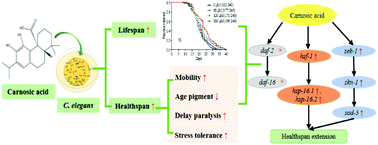Effects on longevity extension and mechanism of action of carnosic acid in Caenorhabditis elegans†
Abstract
The beneficial effects of carnosic acid (CA) on health in terms of antioxidative, anti-inflammatory, antibacterial, anti-cancer and neuroprotective properties have long been recognized. However, the role of CA in aging remains unknown. In the present study, we examined the effects on longevity extension, as well as the mechanism of action, of CA in Caenorhabditis elegans (C. elegans). The results suggest that CA increased the lifespan of C. elegans. Meanwhile, CA was absorbed by the worms and promoted the healthspan of C. elegans by improving the mobility, reducing the accumulation of age pigment, delaying Aβ-induced and polyQ-dependent paralysis and increasing the resistance to heat and oxidative stress. In terms of the mechanism underlying the longevity extension induced by CA, the beneficial effects were associated with the increased expression of SOD-3 but not with ROS scavenging activity. The CA-mediated longevity extension involved the upregulating of the expression of the skn-1, sek-1, sod-5, hsf-1, hsp-16.1 and hsp-16.2 genes but acted independently of the insulin/insulin-like growth factor signaling (IIS) pathway. Furthermore, CA treatment had no impact on the lifespan of skn-1 and hsf-1 mutants, confirming that mitogen-activated protein kinase (MAPK) and heat-shock transcription factor-1 (HSF-1) pathways were associated with the longevity mechanism of CA. These findings contribute to our knowledge of the lifespan extension and underlying mechanism of action of CA in C. elegans.



 Please wait while we load your content...
Please wait while we load your content...